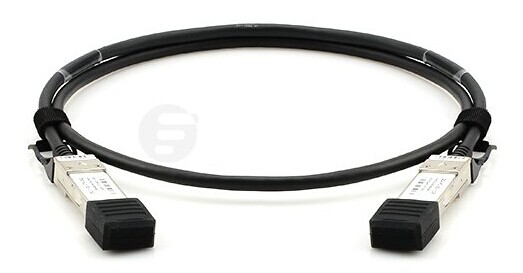The IEEE 802.3ba committee ratified the 40 Gigabit Ethernet standard and along with the general specification, defined a number of fiber optic interfaces. For 40GbE direct cabling between two devices using QSFP+ port, there are several options including QSFP+ transceiver option, QSFP+ DAC (Direct Attach Copper) cable, and QSFP+ AOC (Active Optical Cable). Among these options, each of them has its own merits. This article will compare them and point out which is more cost-effective for your networks.
QSFP+ Transceiver
The 40-Gigabit QSFP+ transceiver module is a hot-swappable, parallel fiber-optical module with four independent optical transmit and receive channels. These channels can terminate in another 40-Gigabit QSFP+ transceiver, or the channels can be broken out to four separate 10-Gigabit SFP+ transceivers. The QSFP+ transceiver module connects the electrical circuitry of the system with either a copper or an optical external network. The transceiver is used primarily in short reach applications in switches, routers, and data center equipment where it provides higher density than SFP+ modules.
Cables for 40 Gigabit Ethernet
Copper Cables: QSFP + to QSFP + copper cable and QSFP + to 4SFP + breakout copper cable are the two common types of QSFP + cables. QSFP + to QSFP + copper cables are hot-removable and hot-insertable. A cable consists of a cable assembly that connects directly into two QSFP + modules, one at each end of the cable. QSFP + to 4 SFP + breakout copper cable is with one QSFP + on one end and four SFP + on the other end. It allows a 40G Ethernet port to be used as four independent 10G ports thus providing increased density while permitting backward compatibility and a phased upgrade of equipment.
Fiber Cables: Active optical cable (AOC) assemblies were invented to replace copper technology in data centers and high performance computing (HPC) applications. The 40G QSFP + AOC is a parallel 40Gbps quad small form factor pluggable (QSFP +) active optical cable, which supplies higher port density and total system cost. The QSFP + optical modules provide four full-duplex independent transmit and receive channels, each are able of 10Gbps operation 40Gbps aggregate bandwidth of at least 100m multimode fiber.
Which to Choose?
Case 1: Distances Below 5 m
If the transmission distances is under 5 m, like the case that two switch ports are connected within the same rack or between racks located within the same room. The QSFP+ passive DAC cable is recommended. Take the Cisco compatible QSFP+ optics for example:
If the transmission distances is under 5 m, like the case that two switch ports are connected within the same rack or between racks located within the same room. The QSFP+ passive DAC cable is recommended. Take the Cisco compatible QSFP+ optics for example:
| DAC | 5m Cisco QSFP-H40G-CU5M Compatible 40G QSFP+ Passive Direct Attach Copper Cable | US$ 65.00 |
| AOC | 5m Cisco QSFP-H40G-AOC5M Compatible 40G QSFP+ Active Optical Cable | US$ 140.00 |
| Transceiver & Cable | Cisco QSFP-40G-SR4 Compatible 40GBASE-SR4 QSFP+ 850nm 150m DOM Transceiver | US$ 85.00 |
| 5M OM4 12-fiber MTP Fiber Optic Trunk Cable for 40GBASE-SR4 | US$ 73.00 |
Case 2: Distances Below 100 m (< 5 m)
For the case that transmission distance is below 100 m but beyond 5 m, the QSFP+ AOC is an ideal choice for use. In this case, the QSFP+ passive DAC cable cannot achieve such long reach requirement because of its performance limitation. While the 40GBASE-SR4 QSFP+ transceiver can do this but the cost of the MTP trunk cable is higher. Thus, here, the QSFP+ AOC is preferred.
For the case that transmission distance is below 100 m but beyond 5 m, the QSFP+ AOC is an ideal choice for use. In this case, the QSFP+ passive DAC cable cannot achieve such long reach requirement because of its performance limitation. While the 40GBASE-SR4 QSFP+ transceiver can do this but the cost of the MTP trunk cable is higher. Thus, here, the QSFP+ AOC is preferred.
Case 3: Distances Above 100 m
If the transmission distance is longer than 100 m, DAC cables and AOCs are usually not recommended. In this case, the 40G QSFP+ modules which are used for short-reach applications are recommended.
If the transmission distance is longer than 100 m, DAC cables and AOCs are usually not recommended. In this case, the 40G QSFP+ modules which are used for short-reach applications are recommended.
40G QSFP+ cables can provide inexpensive and reliable 40G speed connections using either copper cables with distances reaching up to 30ft (10 meters length) or active optical cables reaching even 300ft (100 meters). Of course, all the above are just rough estimates of the optics. In reality, more details should be included according to your specific requirements.

No comments:
Post a Comment